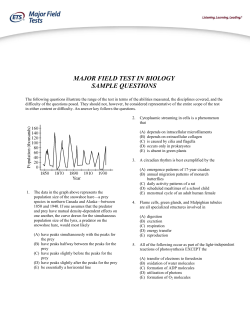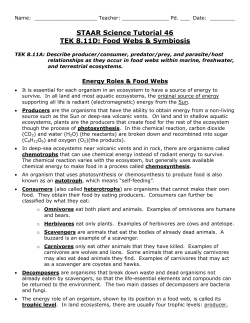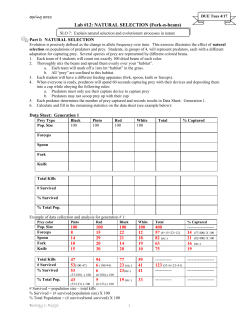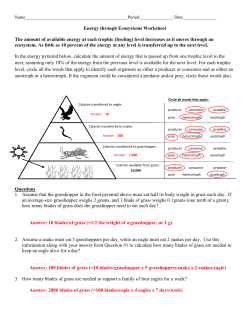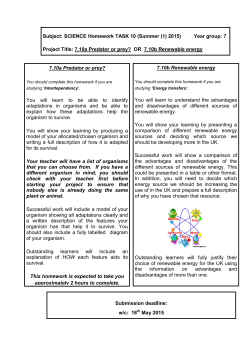
Interacting Species Project
CS 7A - Spring 2015 - Project 2: Interacting Species 3/16/15 1 Purpose To examine ODE models of the interactions of species, to make predictions about changes in the populations, and to study sensitivity to changes in rate constants. 2 2.1 Background Predator Prey The simplest predator and prey models model only exponential growth or decay and the predator-prey interaction: 0 x −a bx x = · y0 −dy c y where x is the predator and y is the prey and all the parameters are positive. 2.2 Prey Overcrowding This model considers the carrying capacity of the prey’s world: 0 x a − bx cx x · = y −ey −d y0 2.3 Overcrowding Both predator and prey may suffer from overcrowding: 0 x a − αx bx x · = 0 y −dy c − γy y 2.4 Constant Harvesting If both predator and prey are “harvested” at rates proportional to their populations: 0 x −a − H1 bx x = · y0 −dy c − H2 y 2.5 Competition Two species may compete for a common resource in short supply: 0 x a − bx −cx x = · 0 y −ey d − f y y 2.6 Satiable Predation When food is plentiful, the predator’s appetite is satiated, and an increase in prey population has little effect on the interaction terms in the rate equations. One model for this is bx 0 −a x x k + y = −dy · y0 y c − γy k+y CS 7A Project 2: Interacting Species - Page 2 of 3 3/16/15 where prey overcrowding is also present. 2.7 Mutualism The system 0 x a bx x = · y0 dy c y describes a symbiotic interspecies relationship that is unbounded by the environment. Observation These models make sense only in the population quatdrant, x ≥ 0, y ≥ 0 An orbit starting in that quadrant always stays there since the positive axes are unions of orbits; the Uniqueness Principle prevents any other orbit from touching the axial orbits. Observation The models have their flaws. No account is taken of the time delay between an action and its effect on population rates. Averaging the rates of change over all categories of age, sex, fertility, and health is of dubious validity. More intricate models could be (and have been) constructed, but most of these have their origins in the models presented above. 3 Problems 1. Consider the Lottka-Volterra model for predator/prey interaction below: 0 x −1 x/100 x · = 0 y −2y/25 2 y Use a computer to graph the population cycles of the following instance of Volterra’s equations. Draw these in the xy-plane. Draw arrowheads on the orbits to show the direction of increasing time. Plot component cuves for 0 ≤ t ≤ 20 in the tx-plance and in the ty-plane and estimate the period T of each. Does T diminish, increase, or stay fixed as the starting points (x0 , y0 ) of distinct orbits are chosen closer to the equilibrium point (25, 100)? Plot enough component curves near equilibrium to estimate the limiting value of the period as (x0 , y0 ) → (25, 100). Write your answers on the graphs. 2. The system of ODEs in the previous problem may be linearized in a region abou tthe equilibrium point (25, 100) by rewriting the ODEs in new variables u = x − 25 and v = y − 100 and discarding all nonlinear terms. Show that the new system is u0 = v/4, v 0 = −8u. Graph orbits and component curves for the linear system, and calculate the (constant) period. Explain why the period should be the same as the limiting period estimated in Problem 1. Write explanations on your graphs. 3. Consider the system with constant effort harvesting: 0 x −1 − H x x = · 0 y y −y 1−H Use initial conditions x(0) = 0.5, y(0) = 1 on the interval 0 ≤ t ≤ 15 to plot orbits for H = 0, 0.25, 0.50, 0.75, 1.00, 3.00 on the same phase plane (x vs. y). Draw arrowhead to show the direction of increasing time on the orbits. For each of the harvesting values, mark the locations of all equilibrium points inside or on the edge of the population quadrant. Explain what happens to the time-average populations as the harvesting is increase from 0 to 1 and beyond. 4. On the basis of problem 3, explain why limited harvesting of both species is a boon to the prey, but not to the predator. A species of ladybug once kept the cottony cushion scale pest of California orange trees under control. During the 1950s the broad-range insecticide DDT was applied to further control the scale. Why did that turn out to be a bad idea? CS 7A Project 2: Interacting Species - Page 3 of 3 3/16/15 5. Overcrowding further limits the growth of the predator-prey community. Set a = d = α = γ = 1, b = c = 2 in the overcrowding model and plot several orbits inside the population quadrant and the corresponding component curves. Explain what is happening. Mark all the equilibrium populations inside or on the edge of the population quadrant. Replot with γ = 2, 3, 4, 5. Explain any significant changes in the nature of the orbits, the component curves, and the periods of cycles. 6. The competition model models the dynamics of a pair of species that compete for a common resource that is in limited supply. Explain the meaning of each term in the x-rate equation. 7. In the competing species model, introduce new variables by letting x = A˜ x, y = B y˜, t = C t˜, where A = a/b, B = a/c, C = 1/a, and then using the old variables names the system can be written as 0 x 1−x −x x = · y0 −a2 y a1 − a3 y y where a1 = d/a, a2 = e/b, a3 = f /c, using three parameters instead of six. Plot many orbits for 0 x 1−x −x x = · 0 −2y 1 − 2y y y (where x survives and y does not) and 0 x 1−x −x x · = y −y 2 − 3y y0 where x and y coexist, marking all equilibrium points inside and on the edge of the population quadrant and inserting arrowheads on the orbits to show the direction of inc reasig time. Beginning with the values of a1 , a2 , a3 in the first model, change the parameters by small amounts, plotting orbits after each change, until you reach the picture of the second model. Continue making small change until a system is obtained in which y survives by x does not. On your last graph write your conclusions.
© Copyright 2025

